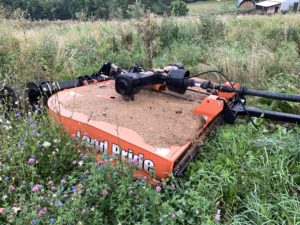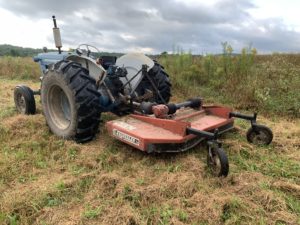Brush Hogs and Rotary Cutters: Multi-purpose Tools for the Small Farm
Brush hogs can knock down vegetation and weeds in a timely manner, and have several very useful purposes.
Small farmers of necessity must accumulate a certain amount of machinery to work their farms and landscapes. One of the most useful tools is what is known as a “brush hog” or “rotary cutter.” Brush hogs are commonly called “bush hogs” but that is a brand name. “Rotary cutter” is another commonly used term to describe the same implement. So just what is a brush hog?
What is a brush hog?

A medium sized brush hog using the three-point hitch that is six feet in width pulled by a 65 h.p. tractor. Rich Taber / Small Farms Quarterly
A brush hog or “bush hog” is a type of rotary mower, typically attached to the back of a farm tractor. The blades are not rigidly attached, like a lawnmower blade, but are on hinges. The rotary blades are not sharpened, and are instead usually quite dull so they whack through dense plant growth.
Smaller brush hogs are mounted on the three-point hitches of tractors. Larger ones are attached to the drawbar of the tractor and the head is raised and lowered by the hydraulic system of the tractor. Yet even larger ones, known as “bat wing” mowers, are similar to the tow behind mowers but have two sides in addition to a mower in the middle, and the sides are raised and lowered hydraulically. These mowers are typically up to fifteen feet in diameter, and need relatively high horsepower tractors.
With relatively smaller tractors found on the typical small farm ,the most common type would be the three-point hitch type, typically covering a pass of 5 or 6 feet. Smaller, walk behind machines with their own engines are also available, which would be handy for less extensive areas.
What are brush hogs used for?
So just what can you accomplish with a brush hog, and why are they so useful on a small farm? Keep in mind that brush hogs are definitely “rough cut” machines. When you get done brushing a piece of land, it won’t look like your nicely manicured lawn. The objective is to knock down the vegetation and weeds in a timely manner.
Brush hogs have several very useful purposes:
- You can trim weeds around your buildings and property that would be too much for the typical riding lawnmower. There is a perverse satisfaction in whacking down those infernal burdocks that have stuck to your animals and clothing for much of the year!
- Brush hogs are used extensively by graziers to mow grazing paddocks, often times at least once a year.
- They can also be used to mow down hayfields that have gotten too mature, and that you didn’t get to mow in a timely fashion. This returns valuable organic matter to the soil. Why would you use a brush hog when you could be using your regular hay mowing machinery to accomplish such a task? Mowing machinery is far more expensive than the typical brush hog; if you’re going to depreciate a machine, it might as well be the less expensive brush hog costing just a few thousand dollars rather than the hay mowing machine that can be about $30,000.
- Brush hogs can be used to keep small meadows open on wooded properties, maintaining valuable early successional habitat which is in critically short supply in the Northeast. They are the premier tool for reclaiming old fields, as well as for maintaining a variety of open habitat types on a rural property. A variety of habitats is conducive to having a variety of wildlife present. Normally it is good to wait until at least mid-July before mowing forest openings and wildlife meadows to prevent any damage to ground nesting birds.
- Brush hogs are almost a necessity for mowing paths that allow you to set up temporary electric net fencing. All of the vegetation must be cleared before you can set out this type of fence.
Should I buy new or used, and what do they cost?

A larger ten-foot brush hog attached at the drawbar and raised and lowered by hydraulics; at least an 85 h.p tractor is needed for this machine. Rich Taber / Small Farms Quarterly
The typical lightweight brush hog for a smaller tractor can cost between $2,000 and $4,000. I have always advocated purchasing good used machinery whenever it is available. However, I tend to favor purchasing a new brush hog when you need to get one. Why do I promote this view? Brush hogs lead hard, rough lives. They spend much of their working lives being bashed off of rocks, tree stumps, and other debris found abandoned in old fields. They end up taking a lot of abuse and strain.
It might be a good idea to save up for and purchase a new machine and then you can treat it with good maintenance and tender loving care. Larger machines such as ten footers can easily cost $10,000 and require at least an 80-horsepower tractor to operate. Larger machines are warranted when you have a lot of pasture to mow.
What are the safety precautions and maintenance required to use brush hogs?
The blades on a rotary cutter can have top speeds of over 150 miles per hour. Therefore the kinetic energy enables the blades to cut through saplings and small trees up to several inches in diameter. Consequently, these mowers can be very dangerous, and contact with the blades would cause severe bodily injury or death.
These cutters also pose a thrown object hazard. Objects such as rocks, stones and roadside debris can be thrown in excess of 300 feet. Do not allow children either in the vicinity or one the tractor when you are operating a brush hog!
Brush hogs normally don’t need a lot of maintenance. Here’s a short list of what you need to do to keep your machine in good working order:
- Grease all bearings especially on the power take off drive shaft.
- Maintain all safety shields, and DO NOT let anyone near them when operating!
- Maintain the proper weight oil in the gear box.
- Sharpen the blades whenever they get dull with a hand held disk grinder.
- Replace the blades when they get really beaten or dull.
- When operating, keep your blades high enough off of the ground so that they don’t dig into the ground.
- Periodically, check your machine so that all bolts and fastenings are tightened snugly.
- In the spring of the year, before the vegetation gets too thick go out and scout your properties and remove any debris which might harm your machine, or you if it gets thrown by the machine when mowing. You can place a stick in the ground with plastic flagging to mark the location of any rocks or other unpleasant anomalies that you can’t remove, and that would be covered by vegetation later in the year.
More Info:
Two excellent sources for locating both new and used farm machinery, with both print editions and web sites available are www.tractorhouse.com and www.fastline.com. Both outfits have editions covering different regions of the country.

